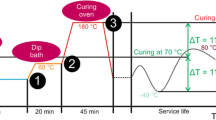Abstract
Modern cars contain about 15 kg of adhesive (IVK 2017). Adhesives are used to avoid corrosion, to stiffen the car body, to obtain a better crash performance, to join different materials that are not weldable, and for sealing purposes. Adhesives are used in powertrain and car body applications. In the car body, up to 200 m of structural adhesives are applied. The trend toward a new lightweight design leads to the necessity to join different materials in a material mix. Here, the use of high strength steels, light metals, and fiber-reinforced plastics has expanded extremely in the last years. In terms of adhesive bond, one has to deal with different surfaces and thermal expansion. Additionally, the adhesive has to act as an electrical insulation to prevent the joint from forming contact corrosion. In this chapter, typical applications for automobiles are shown. Additionally, suitable adhesive properties and surface treatments are discussed.
Similar content being viewed by others
References
ATZ extra (2010) Presentation of the new AUDI A:1
Bieker C, Schlimmer M (2004) Berechnung und Auslegung von Klebverbindungen (Teil 3). Adhäsion, Kleben & Dichten 7:38–42
Bornemann J, Schlimmer M (2004a) Berechnung und Auslegung von Klebverbindungen (Teil 1) Adhäsion. Kleben & Dichten 5:30–33
Bornemann J, Schlimmer M (2004b) Berechnung und Auslegung von Klebverbindungen (Teil 2) Adhäsion. Kleben & Dichten 6:40–42
Brockmann W, Grüner KJ (2003) Betrachtung zum Kriechverhalten von Haftklebstoffen, 17. Internationales symposium Swissbonding, Rapperswil
Burchardt B, Diggelmann K, Koch S, Lanzendörfer B (1998) Elastic bonding. Verlag Moderne Industrie, Landsberg
Burchardt B, Schulenburg JO, Linnnenbrink M (2009) New building blocks for lightweight structures. Adhesion, Adhesives & Sealants 10:22–27
Cognard P (2006) Handbook of adhesives and sealants, vol 2, General knowledge, application techniques, new curing techniques. Elsevier, New York
Deimel A (1993) Fachhochschule München, Einfluss der Klebstoffsteifigkeit auf das Verformungsverhalten geklebter Fahrzeugkomponenten, Diploma work
Hahn O, Wiβling M (2007) Methodenentwicklungzur Berechnung von höherfesten Stahlklebeverbindungen des Fahrzeugbaus unter Crashbelastung. Abschlussbericht Forschungsvereiningung Stahlanwendung e.V, Düsseldorf
Industrieverband Klebstoffe IKV 2017: www.klebstoffe.com/die-welt-des-klebens/anwendungsgebiete/fahrzeugbau.html
Lutz A (2009) Crash resistant two-component adhesives for repairs “As good as new”. Adhesion extra Adhesives & Sealants 10:28–29
Rechner R, Jansen I, Beyer E (2010) Laser- und Plasmaverfahren im wirtschaftlichen Vergleich. Adhäsion, Kleben & Dichten 1–2:36–43
Schulz D (2010) Gut gereinigt ist halb geklebt. Adhäsion, Kleben & Dichten 7–8:18–22
Stepanski H (2010) Punktschweisskleben im Automobilbau. Adhäsion, Kleben & Dichten 5:30–35, 6:35–41
Wisner G, Stammen E, Dilger K, Spiekermeier A, Halanesh M, Hübner S, Behrens B-A (2015) Kleben und Umformen von Stahlblechen in Bonded-Blank-Technik für den Automobil-Rohbau. In: DVS-Berichte Band 315 (2015). DVS Media GmbH, Düsseldorf, S, pp 171–177
Wisner G, Stammen E, Fischer F, Dilger K, Zillessen A, Brodel M. (2014) Accelerated adhesive bonding of wood panels for prefab houses. In: Martínez JMM (ed) EURADH 2014 10th Europeanm adhesion conference – proceedings. 22.04. – 25.04.2014, Alicante/Spain2014. pp 307–310, 2014, ISBN. 978-84-616-8627-8
Author information
Authors and Affiliations
Corresponding author
Editor information
Editors and Affiliations
Rights and permissions
Copyright information
© 2017 Springer International Publishing AG
About this entry
Cite this entry
Dilger, K., Burchardt, B., Frauenhofer, M. (2017). Automotive Industry. In: da Silva, L., Öchsner, A., Adams, R. (eds) Handbook of Adhesion Technology. Springer, Cham. https://doi.org/10.1007/978-3-319-42087-5_46-2
Download citation
DOI: https://doi.org/10.1007/978-3-319-42087-5_46-2
Received:
Accepted:
Published:
Publisher Name: Springer, Cham
Print ISBN: 978-3-319-42087-5
Online ISBN: 978-3-319-42087-5
eBook Packages: Springer Reference EngineeringReference Module Computer Science and Engineering




